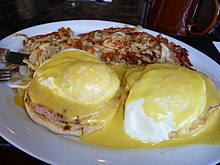English muffin
 A split muffin | |
| Alternative names | Breakfast muffin |
|---|---|
| Type | Bread |
| Course | Bread |
| Place of origin | United States |
| Created by | Samuel Bath Thomas |
| Main ingredients | wheat flour, shortening, milk, sugar, yeast |
English muffins are small, round, flat (or thin) type of yeast-leavened bread which is commonly sliced horizontally, toasted, and buttered.[1] Contrary to what the name might suggest, they were actually invented in the United States by an English immigrant, though the recipe was based on a popular bread product that was sold door-to-door in Victorian-era Britain. Toasted English muffins, which are often served as a breakfast food, are served with sweet toppings (e.g., jam or honey) or savoury toppings (e.g., cooked egg, sausage rounds or bacon and cheese).
Overview

English muffins are commonly available in the United Kingdom, Australia, Canada, New Zealand. They are usually called "muffins" in the UK. In the United States they are called English muffins to distinguish them from American muffins, which are typically larger and much sweeter.
English muffins are most often toasted and then topped with butter and/or jam. English muffins are also used in breakfast sandwiches with meat (bacon, ham, or sausage), egg (fried, scrambled, poached or steam-poached), and cheese. They are an essential ingredient in the breakfast dish Eggs Benedict. English muffins can be purchased in a wide range of varieties, including whole wheat, cinnamon raisin, cranberry, and apple cinnamon, or they can be homemade.
Origin
The word "muffin" is thought to be Low German muffen meaning 'little cakes'.[2] In the past, muffins were sold door to door by hawkers in England as a snack bread before most houses were provided with ovens in the late nineteenth and early twentieth centuries, giving rise to the traditional song "Do you know the Muffin Man?"
Samuel Bath Thomas emigrated from Plymouth, England to New York City in 1874.[3] By 1880 he had opened his own bakery at 163 Ninth Avenue. He invented what he called "toaster crumpets", selling them from the bakery to hotels and grocery stores. They were soft and spongy after baking like Victorian-era English crumpets, but thinner. They were also pre-cut (what was later called "fork-split"), so as to be able to be pulled apart, without the texture being crushed as it would be by slicing. Later they were baked in ovens.[4]
They became popular as an alternative to toast; Thomas opened a second bakery around the corner from the first at 337 West 20th Street in a building that remains known as "The Muffin Building".[3]
The Merriam-Webster dictionary gives the origin of the term "English Muffin" as 1902.[3] In a trademark filing in 1926, it was stated that the Thomas' name of the product was first used in 1894.[3]
The recipe and technique that leads to the unusual texture is a closely guarded secret, although competitors now have similar products.[3]
By country
United Kingdom

'English muffins' are sold by the name "muffins" in all British supermarkets. As in the US they are the foundation for eggs Florentine and eggs Benedict, which commonly feature on UK brunch menus.
Germany
In Germany, English muffins are called Toasties or Toastbrötchen, which translates to toast buns.[5]
United States
Thomas' is a brand of English muffins and bagels in North America, founded by the original inventor of English muffins. Today the company is owned by Bimbo Bakeries USA, which also owns Entenmann's, Boboli, Stroehmann, and Arnold bread companies.
Foster's sourdough English muffins were a popular brand English muffin originally from San Francisco. They were a signature menu item at Foster's restaurants from the 1940s to the 1970s, and continued to be produced as a packaged brand until 2008.
See also
- Crumpet
- List of breads
- List of British breads
- McMuffin
- Muffin – small-sized quickbreads, in American English
- Scone
References
- ^ David, Elizabeth (1977). English Bread and Yeast Cookery. London: Allen Lane. ISBN 0713910267. Contains a discussion on the origins and use of the English muffin.
- ^ http://www.thefreedictionary.com/muffin
- ^ a b c d e "Who invented the English Muffin?". Retrieved 17 November 2015.
- ^ "Wolferman's: A Different Style Of English Muffin".
- ^ "GOLDEN TOAST - Unsere Produkte". Retrieved 5 October 2014.
